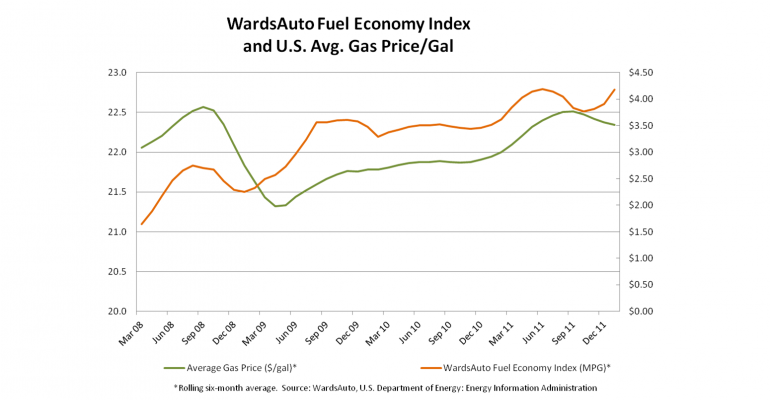The average U.S. light-vehicle fuel-economy rating climbed to a record high of 23.5 mpg (10.0 L/100 km) in January, according to the WardsAuto Fuel-Economy Index.
The new benchmark was set on the heels of an upward trend established in 2011, even as auto makers struggled to meet demand for small, fuel-efficient vehicles in the wake of natural disasters that disrupted production around the world.
The full-year average in 2011 rose to 22.7 mpg (10.4 L/100 km), a 1.7% uptick from 2010’s 22.3 mpg (10.5 L/100 km).
The previous monthly high of 23.1 mpg (10.2 L/100 km) came in March 2011, just prior to the inventory shortages triggered by an earthquake and tsunami in Japan.
The spikes bookend the inventory crisis, suggesting that, barring unforeseen production stoppages, smaller vehicles will continue to trend up, taking the Fuel-Economy Index along for the ride.
The January index rating represents a 4% increase over like-2011 and a 12.4% improvement over the index’s base rating of 20.9 mpg (11.2 L/100 km), established in fourth-quarter 2007.
January’s record efficiency rating was boosted in part by year-to-year improvement in the Environmental Protection Agency’s fuel-economy ratings for many ’12 vehicles. Solid mix-shifts by some auto makers also pushed the index higher.
Year-ago, Chrysler scored an 18.6-mpg (12.2 L/100 km) rating on the January index, with light trucks making up more than 82% of its sales. Light trucks accounted for just 71% of the auto maker’s deliveries last month as its index rating jumped 4% to 19.5 mpg (12.0 L/100 km).
Ford enjoyed a similar rating bump of 5.2% to 21.9 mpg (10.7 L/100 km) – tops among Detroit auto makers. General Motors improved 1.8% to 21.3 mpg (11.0 L /100 km).
Toyota, finally able to stock more of its most efficient vehicles, including an array of new and updated hybrids, led the January index at 26.9 mpg (8.73 L/100 km) – the highest monthly rating for an auto maker to date.
South Korean sisters Hyundai and Kia finished within breathing distance of Toyota, as they tied for second place with twin ratings of 26.8 mpg (8.76 L/100 km). Notably, small cars accounted for an additional 3% of Hyundai’s overall mix, while Kia saw a 12% mix-shift from light trucks to cars in 2011.
Volkswagen had the next-highest score with 26.6-mpg (8.83 L/100), up 5.6% over year-ago.
Led by pickups, all vehicle segment groups improved their index ratings over year-ago.
Traditional bottom-dwellers, the trucks saw a 5.7% jump in January to 16.9 mpg (13.9 L/100 km). That performance tied pickups with SUVs, which recorded a 1.5% improvement, compared with like-2011.
Vans and cross/utility vehicles both gained 2.5% on their year-ago index ratings, scoring 19.8 mpg (11.9 L/100 km) and 22.1 mpg (10.6 L/100 km), respectively.
Midsize- and Large-car ratings inched up less than 1%, according to WardsAuto’s segmentation, but Small Cars improved 4% to a best-ever 29.2 mpg (8.0 L/100 km). And the Luxury-Car segment, which included new hybrids and a number of new smaller models, rose 8.8% on the index to score 22.4 mpg (10.5 L/100 km).
Car performance in total climbed 3.5% on the index, while light trucks ticked up 2.1%
Overall, the index rating for domestically-built vehicles improved 4.5%, to 22.8 mpg (10.3 L/100 km). But North America’s relatively truck-heavy mix lagged behind imports, which scored an even 26 mpg (9.0 L/100 km), up 3.7%.




